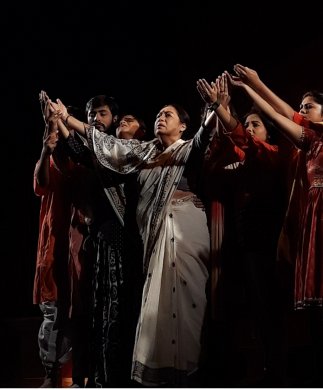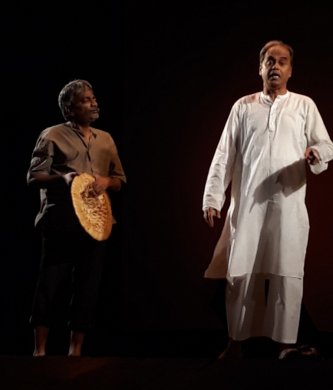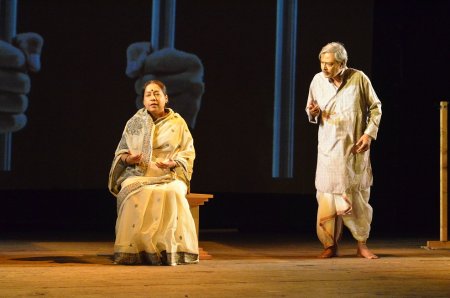
|   |

|   |
 e-mail: ukb7@rediffmail.com Warped world vs. youth power Photos courtesy: Sudrak September 28, 2019 The fossilized, walled-in civilization is a recurring phenomenon in the history of mankind. Tagore penned his seminal play Achalayatan (The Static Institution) in 1912 giving it an India orientation. The play is a satire on a society that stagnates by holding on to rituals, but when rituals are an end in themselves, it is a sign of bondage, for it dries up the vital sap of human life. The moral implication of the theme is archetypal in character, but Tagore draws a powerful picture of social, intellectual and spiritual stagnation. The first small voice of protest is raised by the young novice Panchak who reflects the yearning for freedom from the blind obedience to unnecessary injunctions. How his murmur of dissent snowballs into uproar and how the final arrival of the uppermost authority breaks down the autocracy of meaningless ritualism of the closed hierarchy, is the rest of the story.  
Baijayantika, a play recently presented by Sudrak, takes off on the above story-line from Achalayatan and situates it in the contemporary context of Visva Bharati, Santiniketan, with the cardinal focus being retained around Tagore's creative oeuvre. Written, directed and designed by Debasis Majumdar, the theme is built around a post-graduate student of Visva Bharati, Pratyarthi, who had raised some basic questions that impinge on the present state of the institution. The curtain rises on the disturbing discovery that Pratyarthi is nowhere to be found. The students of the university congregate to launch an agitation for Pratyarthi in a unique style: using Tagore's music, poems, plays and referential quotations as their language of protest. The agitation grows into a serious altercation with the central administration of the institution, who views it in the context of world-wide insurgence of young people. There is no winning over, but the incident makes a great stir in the bedrock of the university's authoritarian leadership. Obviously, the latter suffers a blow and there are stirrings of an intimation of the ultimate victory for the youthful rebellion. The performance has two aspects of an uncommon design: copious usage of Rabindrasangeet (Tagore's songs) and an ensemble acting style by the young generation on the stage, both focused on depicting oppressive pain arising from contradictions of the present day society and people. Would it be a mere ironic coincidence that, while reading this review of a symbolic play of today - taking off from another allegorical classic Tagore play of yesterday -- one would have already witnessed that, responding to the appeal of the 16-year-old Swede, Greta Thunberg, millions of students and adults all over the world had taken to the streets demanding urgent action to avert the disaster of climate change, and tens of thousands of people had clogged Hong Kong's streets demanding democracy, as their 22-year-old leader Joshua Wong appeared before the US Congress seeking support? Indeed, both Thunberg and Wong represent, in a way, the world's conscience to act to escape a terrifying future of a super-heated world leading to mass extinction as well as an authoritarian rule asphyxiating a free-wheeling global metropolis!  Extracts from interview with the director: Your play’s events closely resemble a recent incident of disappearance of a student from Jawaharlal Nehru University, Nayeem, who never returned. Does your symbolism have wider implication? Very much so, it relates to the entire country and the world of our times. What then is your perception of your play's relevance today? The present day, and its social environment coupled with several cultural warps and woofs, is interwoven to form the perception of my play. Grasping them, a drama is developed where I, as the playwright, have taken recourse to Tagore's philosophy and his entire creative works - the works that help to perceive world-wide contemporary socio-economical vis-ŕ-vis political milieu. Your play does have a very unusual form... Yes, the play does take a unique form, which is known in our words as Natyagatha (dramatic lyricism). I should not consider only song or dance as synonym of Natyagatha. During the course of presentation of the total play, Tagore's songs are used piecemeal and, side by side, there are expositions of several essays, letters and poems of Tagore. Do you think you have evolved a new form? I consider that our theatre gets a new form from these expositions, wherefrom I have to move forward to find solution to three contradictions, viz.: 1. To gain a right theatrical exposition of Tagore's philosophy and his creations in the light of contemporary period; 2. To transform parts of Tagore's songs, poems, essays and letters as elements of my theatre; 3. To search for a new communicative theatrical language of actors with audience, which contains abstraction of songs or poems and, at the same time, the usual forms of communication are not hampered. What do you consider to be your end result? I have taken the help of modern technology and cinema for a decent presentation of our theatre. I would reiterate what I had expressed earlier, namely that this is an effort to identify our theatre as a quest for a unique form or an example of never-before presentation style of theatrical art.  Dr. Utpal K Banerjee is a scholar-commentator on performing arts over last four decades. He has authored 23 books on Indian art and culture, and 10 on Tagore studies. He served IGNCA as National Project Director, was a Tagore Research Scholar and is recipient of Padma Shri. Post your comments Please provide your name and email id when you use the Anonymous profile in the blog to post a comment. All appropriate comments posted with name & email id in the blog will also be featured in the site. |